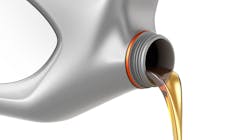There’s not much the maintenance department can do to help fleets on fuel prices and inflation right now, but a renewed focus on engine oil management can help improve fuel efficiency and engine life to defray all the pesky issues biting into fleets’ profit margins.
At the top of the list, of course, is making sure the engine oil is suitable for the engine. You should also factor in the overall benefits an oil marketer’s formulation provides, not just the cost.
See also: The wealth of data in maintenance inspection reports
“Minor changes to get a better performing product translates into a lot of other much more tangible benefits,” noted Tom Gaurke, a commercial business consultant for Chevron. “When we went from 15w-40 to 10w-30, we got about a 1% increase in fuel economy, and that was at $4 per gallon of diesel. That’s $900 in savings per truck per year.”
How much ash content is created in the aftertreatment system is another factor to consider. Chevron formulated its Delo 600 ADF heavy-duty engine oil to 0.4% sulfated ash, which can save fuel and prevent drivers from taking time out of the day to perform a regeneration.
“Over time, as the diesel particulate filter has greater and greater ash accumulation, the number of regens that you have increases and each one of those regens costs you fuel,” Gaurke added. “Not only does Delo 600 generate a much smaller amount of ash, but that ash is packed in the DPF more densely, so for the same amount of ash getting put into the DPF, you’re actually able to hold more of it and prolong the DPF.”Oil drain intervals
Next, ensure the oil drain interval (ODI) schedule matches reality. Going too long between oil changes will make the engine work harder and reduce fuel efficiency, and the properties that reduce friction among moving parts also degrade, exacerbating wear and tear. On the other hand, premature oil changes can drain resources, labor, and asset uptime.
Paul Cigala, commercial vehicle lubricants applications engineer at ExxonMobil, noted that small fleets and owner-operators may take this precautionary approach to drain intervals based on, perhaps, what their dad might have done. These users are “throwing good oil away” that Cigala said larger fleets would gladly put in their own engines because “there’s still life left in there.”
And with oil in general becoming more scarce across the globe, the transportation industry must rethink this conservative strategy and work to conserve more oil. By finding the perfect time to perform ODIs, fleets will ensure the engine oil does not hinder fuel efficiency and, at the same time, does not take up technicians’ time by performing oil changes too early.
That’s why Cigala advises fleets with whom he works to implement a used-oil analysis program.
“If your OEM allows a 40,000-mile oil drain interval, and you’re doing it at 15,000 miles, I’ll say, ‘Let’s take a look at the data,’” he explained.
A used-oil analysis involves taking samples from oil while in the engine and testing for contaminants and lubricant chemical integrity.
This data has been enlightening for customers using Mobil Delvac’s used-oil analysis program. Stewart-Haas Racing’s trucks that haul NASCAR vehicles and parts across the country extended ODIs from 20,000 miles to 70,000.
“There’s less downtime for us and a lot more time to chase the checkered flag,” noted Gary Geissman, Stewart-Haas Racing’s fleet manager.
Texas Transportation pushed the ODIs on their Detroit Diesel engines from 50,000 to 70,000 miles, saving $734,000 annually and cutting labor by 475 hours annually.
Cigala said fleets that regularly sample used oil can also detect EGR cooler leaks, fuel dilution, and excessive wear metals inside of the engine.
According to Darryl Purificati, senior technical adviser, OEM/Automotive for Petro-Canada Lubricants, some important pieces of the engine efficiency puzzle include “keeping the overall performance at an optimal level for the longest amount of time, extending drain intervals with proper oil maintenance, and ensuring that the critical components within an engine are being protected with an oil analysis program.”
This can be tracked digitally with a solution like Petro-Canada’s LUBE 360 Oil Diagnostics solution, Purificati said. Fleet managers can input samples and access results from a PC or mobile device via a customizable dashboard, which he said “prioritizes critical results and detects abnormal conditions before they cause costly repairs.”
“Fleet managers can benefit from expert analysis and recommended maintenance activities based on their oil sample results,” Purificati added. “They can track maintenance events, manage sampling schedules, and receive email reports sent directly to them and their team for one site or across multiple sites.”
For example, sampling can alert a fleet to glycol or coolant in the engine oil, which could indicate a failing EGR cooler seal; or iron and aluminum, which could signal a failing camshaft, coolant leak, or that the engine needs a mechanical adjustment.
This article originally appeared on FleetMaintenance, the sister site of FleetOwner.
About the Author
John Hitch
Editor
John Hitch is the editor-in-chief of Fleet Maintenance, providing maintenance management and technicians with the the latest information on the tools and strategies to keep their fleets' commercial vehicles moving. He is based out of Cleveland, Ohio, and was previously senior editor for FleetOwner. He previously wrote about manufacturing and advanced technology for IndustryWeek and New Equipment Digest.


